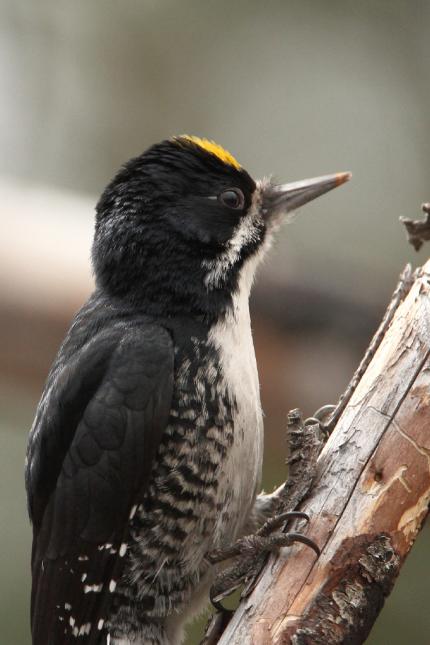The black-backed woodpecker is in danger of population decline through loss of breeding and foraging habitat. They inhabit mature and old-growth lodgepole pine, ponderosa pine, and mixed-conifer forests with numerous standing dead trees. They are most abundant in burned and insect-infested stands.
Description and Range
Physical description
The black-backed woodpecker is 9 inches long. It has a black head and back. The underside is white with black barring on the sides of the bird. A white bar extends horizontally from the base of the beak along the neck. The adult male has a yellow patch on its head.
Ecology and life history
Black-backed woodpeckers primarily inhabit standing dead lodgepole pine, ponderosa pine, western larch and mixed coniferous forests. Disturbed forests with pole- and small sawtimber-sized snags and logs are attractive to the woodpecker because they feed on insects (mainly larvae of wood-boring beetles ) that are particularly abundant in burned versus unburned forests. During winter months, the woodpeckers forage upon standing dead trees, and preferred western larch within burned forests of northeast Washington.
In mature ponderosa pine and mixed conifer forests, black-backed woodpeckers nest predominately in cavities in ponderosa and lodgepole pine; however, tree species composition varies regionally and appears not to be as important a factor as forest condition (such as burned, insect damaged) for explaining the presence of nesting birds.
Geographic range
The black-backed woodpecker inhabits the boreal forests of North America, including the Cascade Mountains, the northern portions of the Sierra Nevada and Rocky Mountains, much of Canada, southeastern Alaska, northern New England, and the upper Midwest.
In Washington , this woodpecker is found on the eastern slopes of the Cascade Mountains and in the coniferous forests of the Okanogan Highland, Selkirk and the Blue Mountains.
For a map of range-wide distribution and conservation status of this species, check out NatureServe Explorer.
Conservation
Suitable mature, old-growth and recently dead lodgepole pine, ponderosa pine and pine-dominated mixed coniferous forest stands that have experienced recent pine beetle infestation, large blowdowns or fire are important for the black-backed woodpecker. The traditional approach of managing cavity nesters by retaining a relatively small number of snags and green replacement trees in harvested stands may not maintain enough foraging substrate to sustain viable black-backed woodpecker populations. Instead, this specialized species may require larger areas of decaying, multi-layered older forests.
Conservation Threats and Actions Needed
- Agriculture side effects
- Threat: Forest management policies that reduce occurrence of large, high intensity wildfires which create woodpecker habitat.
- Action Needed: Re-evaluate fire management policies based on fire suppression.
- Threat: Post-fire salvage logging is detrimental to the woodpecker.
- Action Needed: Where salvage logging is planned, delay any work for at least 5 years to enable wood-boring beetles to become established and provide a food source for the woodpeckers.
Resources
References
Bull, E. L., S. R. Peterson, and J. W. Thomas. 1986. Resource partitioning among woodpeckers in northeastern Oregon. USDA Forest Service Research Note PNW-444.
Dixon, R. D., and V. A. Saab. 2000. Black-backed woodpecker (Picoides arcticus). Number 509 in A. Poole and F. Gill, editors. The birds of North America. Academy of National Science and American Ornithologists’ Union, Philadelphia, Pennsylvania, USA.
Goggans, R., R. D. Dixon, and L. C. S. Seminara. 1988. Habitat use by three-toed and black-backed woodpeckers, Deschutes National Forest, Oregon. Nongame Project Number 87-3-02, Oregon Department of Fish and Wildlife, Bend, Oregon, USA.
Kreisel, K. J., and S. J. Stein. 1999. Bird use of burned and unburned coniferous forests during winter. Wilson Bulletin 111:243-250.
Lewis, J., E. A. Rodrick, and J. M. Azerrad. 2003. Lewis' woodpecker. Pages 27-1; 27-4 in E. Larsen, J. M. Azerrad, N. Nordstrom, editors. Management Recommendations for Washington's Priority Species, Volume IV: Birds. Washington Department of Fish and Wildlife, Olympia, Washington, USA.
